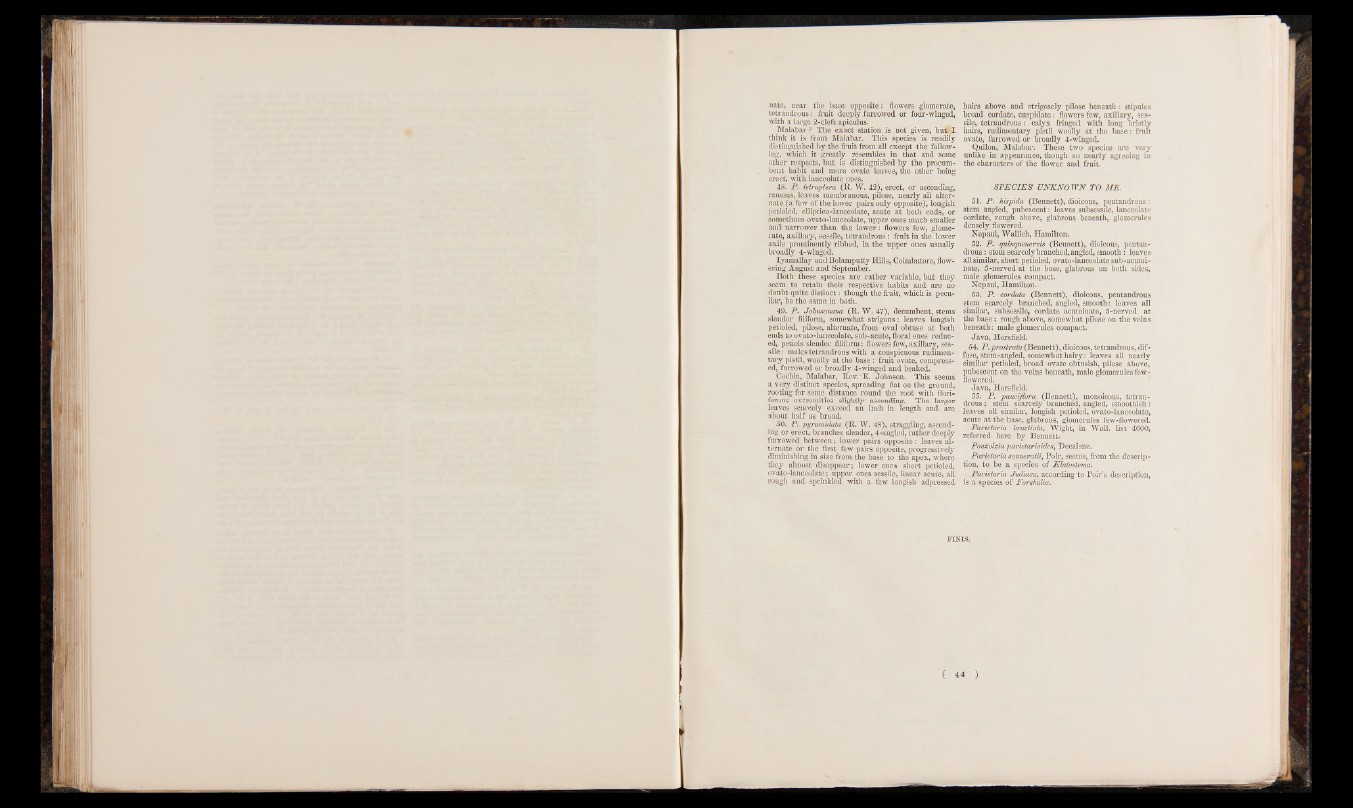
nate, near the base opposite: flowers glomerate,
tetrandrous: fruit deeply furrowed or four-winged,
with a large 2-cleft apiculus.
Malabar? The exact station is not given, but. I
think it is from Malabar. This species is readily
distinguished by the fruit from all except the following,
which it greatly resembles in that and some
other respects, but is distinguished by the procumbent
habit and more ovate leaves, the other being
erect, with lanceolate ones.
48. P . tetraptera (R. W. 42), erect, or ascending,
ramous, leaves membranous, pilose, nearly all alternate
(a few of the lower pairs only opposite), longish
petioled, elliptico-lanceolate, acute at both ends, or
sometimes ovato-lanceolate, upper ones much smaller
and narrower than the lower: flowers few, glomerate,
axillary, sessile, tetrandrous: fruit in the lower
axils prominently ribbed, in the upper ones usually
broadly 4-winged.
lyamallay and Bolamputty Hills, Coimbatore, flowering
August and September.
Both these species are rather variable, but they
seem to retain their respective habits and are no
doubt quite distinct: though the fruit, which is peculiar,
be the same in both.
49. P . Johnsonana (R. W. 47), decumbent, stems
slender filiform, somewhat strigous: leaves longish
petioled, pilose, alternate, from oval obtuse at both
ends to ovato-lanceolate, sub-acute, floral ones reduced,
petiols slender filiform: flowers few, axillary, sessile
: males tetrandrous with a conspicuous rudimentary
pistil, woolly at the base: fruit ovate, compressed,
furrowed or broadly 4-winged and beaked.
Cochin, Malabar, Rev.'E. Johnson. This seems
a very distinct species, spreading flat on the ground,
rooting for some distance round the root with flori-
ferous extremities slightly" ascending. The larger
leaves scarcely exceed an inch in length and are
about half as broad.
50. P. pyramidata (R. W. 48), straggling, ascending
or erect, branches slender, 4-angled, rather deeply
furrowed between; lower pairs opposite: leaves alternate
or the first few pairs opposite, progressively
diminishing in size from the base to the apex, where
they almost disappear; lower ones short petioled,
ovato-lanceolate; upper ones sessile, linear acute, all
rough and sprinkled with a few longish adpressed
hairs above and strigosely pilose beneath: stipules
broad cordate, cuspidate: flowers few, axillary, sessile,
tetrandrous: calyx fringed with long bristly
hairs, rudimentary pistil woolly at the b a se : fruit
ovate, furrowed or broadly 4-winged.
Quilon, Malabar. These two species are very
unlike in appearance, though so nearly agreeing in
the characters of the flower and fruit.
SP E C IE S UN K NOWN TO ME.
51. P . hispida (Bennett), dioicous,. pentandrous:
stem angled, pubescent : leaves subsessile, lanceolate
cordate, rough above, glabrous beneath, glomerules
densely flowered.
Nepaul, Wallich, Hamilton.
52. P . quinquenervis (Bennett), dioicous, pentandrous
: stem scarcely branched, angled, smooth : leaves
all similar, short petioled, ovato-lanceolate sub-acuminate,
5-nerved at the base, glabrous on both sides,
male glomerules compact.
Nepaul, Hamilton.
53. P . cordata (Bennett), dioicous, pentandrous
stem scarcely branched, angled, smooth : leaves all
similar, subsessile, cordate acuminate, 5-nerved at
the base ; rough above, somewhat pilose on the veins
beneath : male glomerules compact.
Java, Horsfield.
54. P.prostrata (Bennett), dioicous, tetrandrous, diffuse,
stem-angled, somewhat hairy : leaves all nearly
similar petioled, broad ovate obtusish, pilose above,
pubescent on the veins beneath, male glomerules few-
flowered.
Java, Horsfield.
55. P . paudflora (Bennett), monoicous, tetrandrous
; stem scarcely branched, angled, smoothish :
leaves all similar, longish petioled, ovato-lanceolate,
acute at the base, glabrous, glomerules few-flowered.
Parietaria bractiata, Wight, in Wall, list 4600,
referred here by Bennett.
Pouzolzia parietarioides, Decaisné.
Parietaria sonneratii, Poir, seems, from the description,
to be a species of Elatostema.
Parietaria Jndiaca, according to Poir’s description,
is a species of Forskalia.
FINIS.